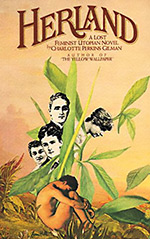
![]() Rhondak101
Rhondak101
12/17/2011
![]()
The only thing that I’d read by Charlotte Perkins Gilman was her short story “The Yellow Wallpaper,” which I’ve taught many times in my career. I enjoy teaching it very much because of the ambiguity in the characterization. Her novel Herland (1915) does not have that ambiguity; while the characters are not strictly allegorical, they all do represent a type, a point to which I will return. This does not mean that the plotting and prose are heavy-handed, as you often find in polemic types of writing. Gilman’s prose is fluid and readable.
The premise of Herland is that three American adventurers, while on a larger expedition to map rivers (presumably in South America), learn of a community made solely of women who live high in the mountains. The three men resolve to return and find this community. Terry O. Nicholson is the playboy-adventurer who finances the trip. His companions are Jeff Margrave, a doctor with a poetic soul, and Vandyke Jennings, the sociologist who serves as the narrator of the story. As the men encounter this feminine utopia, their reactions display types of masculinity. Nicholson thinks of women as objects to be conquered and does not function well in a society where there is not any competition, not even in the games. Margrave subscribes to “exalted gallantry. He idealized women, and was always looking for a chance to ‘protect’ or ‘serve’ them. These needed neither protection nor service” (76). Jennings represents the middle ground, and as a sociologist, he wants to understand and analyze the society. The women think he is more like them, like People, they say.
The utopia the men find combines the typical pastoral utopia in which the women grow and harvest their own vegetarian diet with a modern culture which has technology and industry that rivals the early-twentieth-century society of the men. Therefore, Gilman’s women are neither backward nor innocent—just different. Their reproduction by parthenogenesis evolved more than two thousand years earlier when a volcanic eruption, followed by a slave revolt, killed most of the men in the community. The eruption closed off the pass into their land, leaving the women isolated. Gilman injects heterosexual compulsion into this asexual society, which, of course, furnishes the conflict in the plot. The resolution leads to a sequel, With Her in Outland, that I didn’t know existed until I read about it on the internet.
While the men’s ideas of femininity and womanhood are dated, Herland does not really seem dated except in its delicacy about sex. It seems much like contemporary writer offering a fantasy in a historical setting. I certainly recommend this book as it queries many of our assumptions about gender, education, and religion.